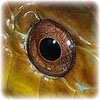| This article is still under construction. |
Snakes are often presented to the veterinarian for eye problems so knowledge of the normal anatomy of the ophidian eye is essential. The eyesight of snakes is relatively inefficient and the eye is reduced or absent in some fossorial snakes.
- Spectacle - The embryologically-fused eyelids (hence no palpebral fissure) form a transparent covering of the eye called the spectacle (also known as the brille or eyecap). Between the spectacle and the cornea are tear-like secretions. The spectacle is shed during normal ecdysis but may be pathologically retained (for example if mites are present, with low humidity or if the eye is diseased).
- Tears - All reptiles produce tears. In snakes, tears produce a region of lubrication between the cornea and the spectacle, allowing the free movement of the eye. Paired nasolacrimal ducts drain the sub-spectacular spaces into the mouth near the vomeronasal organ. Tears cannot overflow the eyelids, as in mammals, so if a nasolacrimal duct is damaged there is a build-up of tears under the spectacle, which leads to a bullous spectaculopathy.
- Cornea - The pupil is commonly elliptical or round and may give an indication of habitat and lifestyle. Often diurnal species have round pupils and nocturnal species have vertical pupils. Coral snakes and all New World non-venomous snakes, except the boa constrictor have round pupils, while pit vipers have vertical slit pupils.
- Sclera - The eye has no ossicles (unlike other reptiles) and the sclera is composed entirely of tendinous connective tissue.
- Posterior segment - The retina is usually grey mottled with white or red spots and appears with semi-opaque nerve fibres radiating uniformly outwards from the optic disc that is obscured in families having a conus. It is avascular and the membrana vasculosa retinae supply nutrients.

